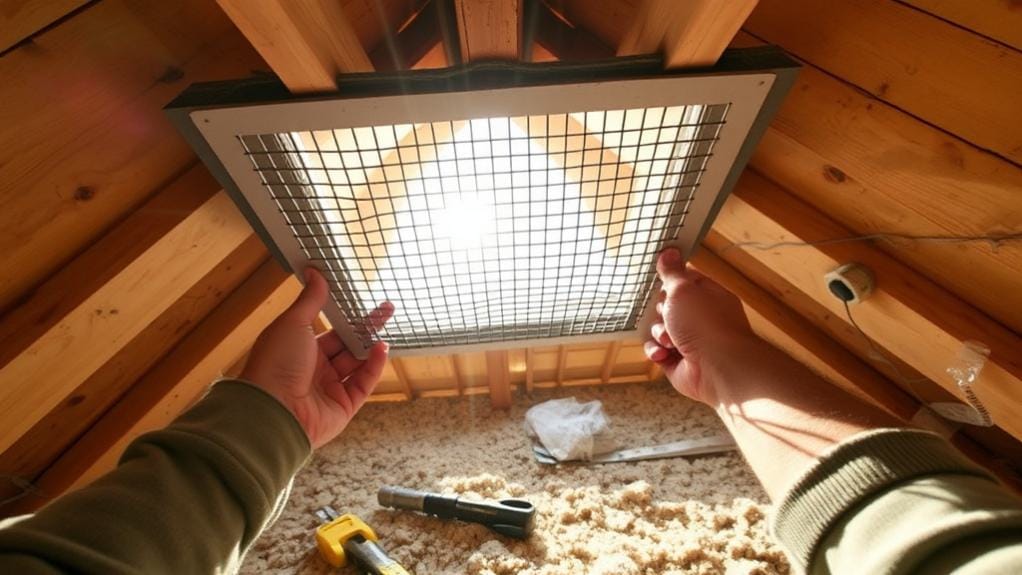Want to keep those pesky possums out of your attic this weekend? I've got your back with a simple game plan. Start by grabbing a flashlight and inspecting your roof for any gaps or damaged vents – those are your possum's VIP entrance tickets. Seal small openings with caulk and cover larger holes with metal mesh screening. Don't forget to remove their dinner invitations by securing outdoor pet food and trash cans. Install motion lights and trim those tree branches that serve as their personal highways to your roof. Trust me, there's plenty more sneaky tactics these critters use to crash your attic party.
Why Opossums Choose Your Attic
Table of Contents

An opossum seeking shelter in your attic isn't just looking for a temporary hideout – it's searching for prime real estate.
These nocturnal squatters view your cozy attic space as the perfect spot to raise their families, far from predators and nosy humans. The best defense is sealing entry points before they find their way inside.
Think your attic isn't appealing? Think again.
These expert climbers love:
- Warm, dark spaces perfect for nesting
- Easy entry points through damaged vents or gaps
- Your forgotten pet food and stored snacks
- Quiet daytime sleeping spots
- Free insulation for their babies
Pro Tip: If you hear scratching at night, don't wait to call pest control. Where there's one opossum, there might be a whole family moving in.
And let's be real – these aren't ideal roommates.
They bring unwanted guests like parasites and disease. Your attic wasn't meant to be a possum paradise.
Essential Tools For Attic Protection

Success in possum-proofing your attic starts with having the right tools on hand. I'll break down exactly what you need to send those unwanted roommates packing – and trust me, they won't be leaving a forwarding address.
| Tool | Purpose | Priority |
|---|---|---|
| Flashlight | Spot entry points | Essential |
| Sturdy ladder | Safe attic access | Essential |
| Caulk | Seal small gaps | High |
| Mesh screening | Cover vents/eaves | High |
| Live trap | Humane removal | Medium |
Look, you wouldn't go into battle without armor, so don't tackle your possum problem without proper gear. Your flashlight's going to be your best friend for spotting those sneaky entry points. And please – don't try balancing on that rickety old stepstool. A sturdy ladder isn't just smart, it's vital unless you enjoy unexpected trips to the ER.
*Pro Tip: Double-check your batteries before heading up there. A dead flashlight means game over.*
Inspect Your Roof Entry Points

I'll tell you exactly what to inspect:
- Check every inch of your soffits and vents. Those gaps might look tiny to you but they're basically possum highways.
- Hunt down loose fascia boards – they're like welcome signs for opossums seeking cozy winter lodging.
- Scan your shingles and eaves for wear. One small hole today = possum party central tomorrow.
For effective prevention, consider installing durable steel mesh around potential entry points, as it's proven highly resistant to persistent pests.
*Pro tip: Don't wait for scratching sounds to start your inspection. I recommend checking these entry points every season.
And when you find gaps? Seal them immediately with heavy-duty materials. Those determined little climbers won't take no for an answer.*
Seal Gaps And Vulnerable Areas

Taking action to seal gaps is your next critical step in possum-proofing. I'm not kidding – those crafty critters will exploit every tiny opening they find.
Just like strong climbing raccoons, possums are experts at finding ways into your home through the smallest openings. Let's shut them out for good.
Here's exactly what you need to do:
- Grab some caulk and expanding foam for those annoying small entry points (because possums don't need a welcome mat)
- Cover larger holes with hardware cloth or metal mesh – and don't cheap out on this part
- Secure those loose fascia boards and soffits (yes, even that one you've been ignoring)
Pro Tip: Don't forget those vent covers! Your attic needs to breathe, but not become a possum paradise.
Check your work twice. Trust me – missing one tiny gap is like leaving your front door wide open with a "Free Rent" sign.
Remove Attractants Around Your Home

While sealing entry points is essential, eliminating what draws possums to your property in the first place will dramatically boost your defense strategy.
Let's talk about removing attractants – you know, all those tasty temptations that make your home a 5-star possum resort. First, stop leaving pet food outside overnight (seriously, why are you doing that?). Store those kibbles indoors where they belong.
Heavy-duty locks with 2,000+ pound breaking strength will guarantee your outdoor bins stay tightly sealed against determined wildlife.
Here's what else you need to handle:
- Secure those garbage cans with animal-proof lids – because no one wants a midnight possum buffet
- Clean up fallen fruit regularly – your backyard isn't a wildlife snack bar
- Trim those overhanging tree branches – they're basically possum highways to your attic
- Keep compost covered and food scraps contained
Pro Tip: *The cleaner you keep your yard, the less likely possums will view your home as their next entry-level apartment.*
Proper Tree And Shrub Management

Proper landscaping serves as your first line of defense against unwanted possum visitors.
Let's face it – those excellent climbers will use anything they can to reach your attic. Unlike smaller attic pests, possums require sturdier climbing routes to access your home. Time to show them who's boss.
Start by trimming those pesky tree branches that overhang your roof.
Trust me, possums love using them as their personal highways straight to your home. Don't give them the satisfaction!
Next up:
- Clear fallen fruit regularly – unless you're running a possum buffet
- Trim back dense vegetation that provides hiding spots
- Install thorny shrubs as a natural barrier (yes, make them work for it!)
Pro Tip: Focus extra attention on trees closest to your house. Even a small branch can become a possum's favorite entrance route.
Remember: A well-maintained yard isn't just pretty – it's your best defense against these nocturnal nuisances.
Installing Physical Barriers

Now that you've secured your yard against possum invasions, let's focus on fortifying your attic itself. Trust me – installing physical barriers is your best shot at effective possum control. I'll show you exactly how to secure openings like a pro.
First, inspect your attic thoroughly. Those sneaky critters can squeeze through surprisingly small spaces.
Here's what you need to do:
- Cover all roof vents with 1/4-inch metal screening – anything bigger and you're basically rolling out the welcome mat.
- Seal gaps around pipes and wires (seriously, don't skip this).
- Fix loose fascia boards and patch holes in eaves.
- Install metal mesh over any suspicious entry points.
*Pro tip: Don't cheap out on materials. That $2 plastic mesh you're eyeing? It'll last about as long as a chocolate teapot against a determined possum.*
Natural Deterrent Methods

Several natural deterrents can complement your physical barriers, making your attic even less appealing to possums.
I'll show you how to create unpleasant aromas that'll have these critters running for the hills.
Start by targeting those entry points with these proven repellents:
- Splash some vinegar around openings (yes, it stinks – that's the point!)
- Sprinkle used coffee grounds near access areas
- Plant mint or use eucalyptus oil – possums hate that spa-like smell
Pro Tip: Remove all food sources first. The best deterrent is a boring attic with nothing to eat.
For extra punch, I recommend:
- Motion-activated sprinklers (surprise shower, anyone?)
- Bright lights that kick on when they approach
- Citrus peels scattered around entry zones
Trust me – deterring opossums is all about making your attic the least inviting crash pad in town.
Professional Inspection And Repairs

Getting a professional inspection is your smartest move for long-term possum protection.
Let's face it – you're not a wildlife control expert, and that's okay! A pro will spot those sneaky entry points you'd probably miss while doing your DIY inspection (no offense).
Here's what you'll get with professional help:
- Complete attic assessment for gaps, loose boards, and those oh-so-inviting cracks
- Expert detection of possum evidence (because those droppings aren't just random decorations)
- Professional-grade repairs to seal every potential entry point
- Follow-up visits to guarantee those pesky possums stay out
*Pro Tip: Always ask about warranties! A good wildlife control service will guarantee their work against future infestations.
Trust me – it's worth every penny to avoid playing possum detective again next season.*
Long-Term Prevention Strategies

The best defense against possums is a solid prevention plan that goes beyond basic repairs.
Trust me – these crafty pest species will find any point of entry you've overlooked, so let's get serious about keeping them out for good.
Start with the basics:
- Secure those trash cans (unless you enjoy midnight possum parties)
- Move pet food inside (yes, ALL of it)
- Install motion lights (surprise parties aren't fun for possums)
Beyond possum repellents that rarely work, focus on these humane methods:
- Trim tree branches away from your roof – possums aren't great jumpers
- Add mesh screens to vents and openings
- Regularly inspect for new holes (anything bigger than a quarter is trouble)
*Pro Tip: Skip the live traps unless you've got a plan for relocating caught possums.
Prevention beats eviction every time.*
Frequently Asked Questions
How Do You Get Possums Out of Your Attic?
I'd set up humane live traps with fish or pet food to catch possums in your attic. Monitor traps regularly, remove them promptly, seal entry points, and clean the space thoroughly afterward.
How Do I Make My Attic Rodent Proof?
Proper planning prevents pests! I'd seal all entry points with metal mesh and caulk, install vent screens, trim overhanging branches, and keep my attic clean. These steps guarantee my space stays rodent-free.
What Is the Fastest Way to Get Rid of a Possum?
I recommend using a live trap baited with fish or cat food where you've seen possum activity. I'll check it daily and relocate any caught possums at least 10 miles away for best results.
What Scares Possums?
I've found that possums fear loud noises, bright lights, and strong smells. I'll tell you they're especially scared of clapping, banging pots, motion-activated lights, and even the presence of dogs and cats.
Last Word
Let's face it – nobody wants a possum party in their attic. I've given you everything you need to send those marsupial squatters packing. Your mission (should you choose to accept it) is clear: seal those gaps, remove the snacks, and show those possums who's boss. Don't wait until you hear tiny footsteps overhead at 3 AM. Take action now, or you might find yourself sharing your attic with some unwanted nocturnal neighbors.








